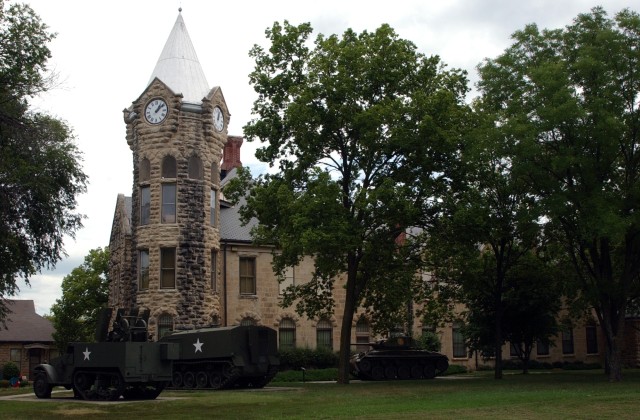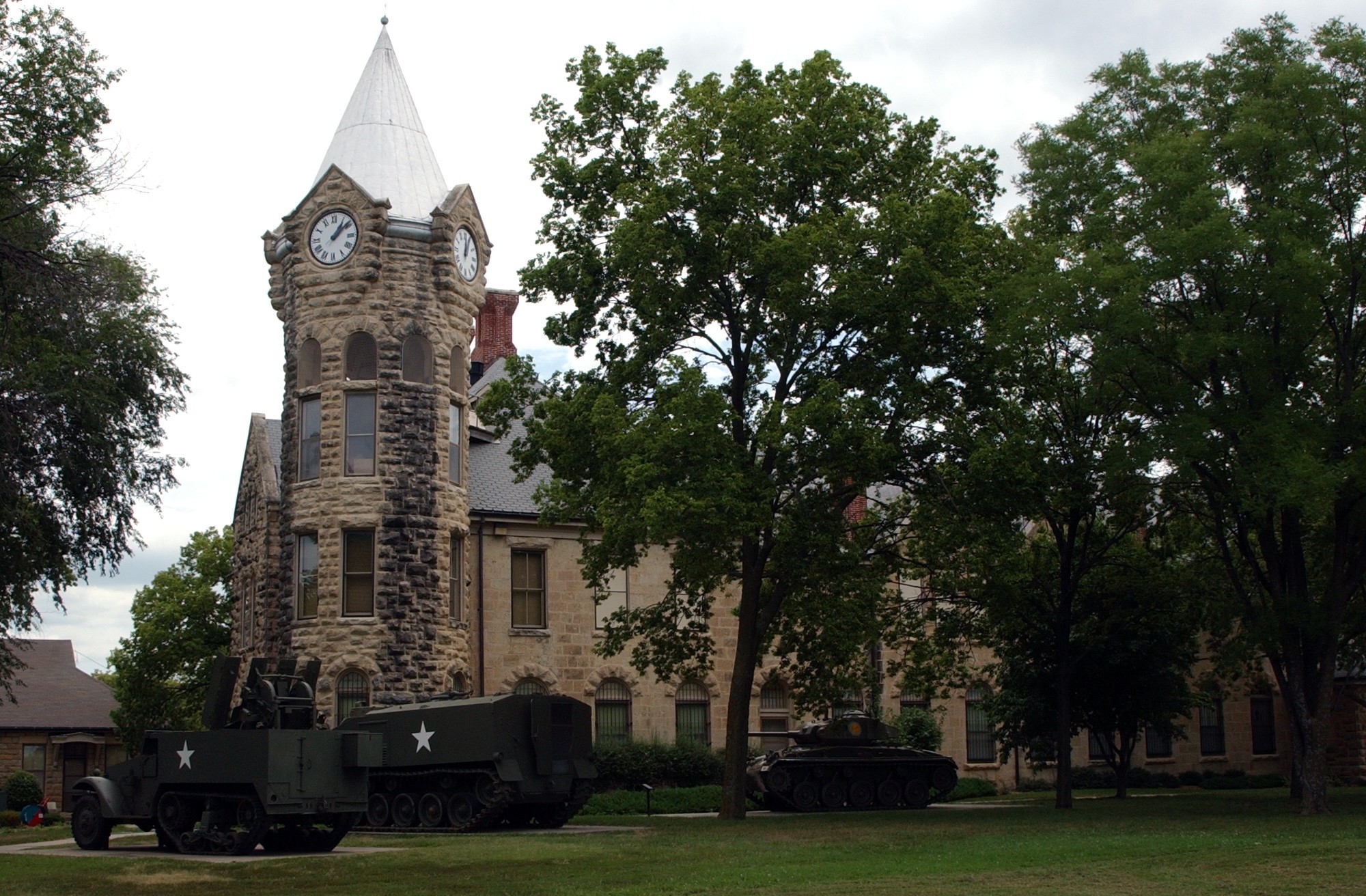FORT RILEY, Kan. - Tanks, scout vehicles and a bronze horse can be seen in the courtyard. Cottonwood trees shade the lawn from the hot summer sun. Visitors from all areas of Kansas explore the grounds. While all this can be seen outside, the limestone buildings of the U.S. Cavalry and 1st Infantry Division museums house pieces of Fort Riley and the U.S. Army\'s history.
1st Infantry Division Museum The 1st Infantry Division Museum, which is part of the U.S. Army Center of Military History Museum system, offers a detailed description of the division's history and is home to a percentage of the division's artifacts dating from 1917 to Operation Desert Storm. "We have exhibits on World War I, the interwar years, World War II, Vietnam and Desert Storm," 1st Infantry Division Museum and U.S. Cavalry Museum Director William McKale, 1st Infantry Division Museum and U.S. Cavalry Museum Director, said.
"We also touch on REFORGER (Return of Forces to Germany) exercises, and we do have a small area that does present some material from OIF (Operation Iraqi Freedom) on the first floor." Although located on Fort Riley, the museum has not always been local. McKale said the 1st Infantry Division Museum opened in 1992 on the 75th anniversary of the division's formation but relocated to Wurzburg, Germany. "It moved to Leighton Barracks in 1995 when the division headquarters moved," McKale said. "Over the next decade, they established a very nice museum."
Eventually, 1st Inf. Div. headquarters found its way back to the United States with museum in tow. "When the Army directed division headquarters back to Fort Riley, we coordinated with the 1st Infantry Division Museum in Germany to bring approximately 500 artifacts related to the 1ID back to Fort Riley with the intent of exhibiting part of that collection in Building 207," McKale said. The museum, which took in about 20 percent of the artifacts from the museum in Germany, has been located in Building 207 since its re-opening in August 2006. While also open to the public, McKale said the museum is generally used as a training tool for incoming Soldiers - allowing them to understand their place in overall history and to instill an attitude that makes a Soldier proud to be part of the Big Red One. "I would hope that it would have a role," McKale said.
"It depends on how that Soldier applies what they see and learn in there to their own situation. Part of our job is to make that connection with the Soldier. You've got day to day, week to week things to worry about and jobs to do, but I it's important that we occasionally step back from that routine and put ourselves in touch with this history that explains why there is a Fort Riley, why there is a 1st Infantry Division and what roles those entities have had in the past, and why we are here today." Mannequins dressed as Soldiers from each time period are displayed throughout the museum, as weapons and other artifacts depict how a Soldier might have been equipped. Visitors are thrown directly into World War I as they make their way through a replicated trench. Here, they can look out over the field and get a feel for what trench warfare was all about.
The museum also houses a foxhole display and diorama of the battle occurring on Omaha Beach. As time rolls on, so does Big Red One history. McKale said the museum has a pending contract to install exhibits on Bosnia, Kosovo deployments, Operation Iraqi Freedom, Operation Enduring Freedom and an exhibit in remembrance of fallen soldiers and Army families. McKale said the exhibits are in preparation and anticipates them being done sometime in September.
While Fort Riley is home of the Big Red One and the 1st Infantry Division Museum, it's not the only one of its kind. "There is a 1st Infantry Division Museum in Wheaton, Ill.," McKale said. "It is a private museum that has close ties to the Big Red One and is operated by the McCormick Foundation based in Chicago. We cooperate on joint ventures and work together to preserve the rich history of the Big Red One." McKale also said exhibits like the Omaha Beach battle and World War I trench give Soldiers a sense of the environment their predecessors had to fight in. The 1st Infantry Division Museum usually accommodates 20,000 guests per year according to McKale.
U.S. Cavalry Museum Much like the 1st Infantry Division Museum, the U.S. Cavalry Museum, located in building 205, exhibits a significant piece of U.S. Army history. Paintings, weapons, tools and various other artifacts enlighten the prestigious story of the U.S. Cavalry.
"The Cavalry Museum is also part of the U.S. Army Center of Military History Museum system and tells the history of the mounted branch from the Revolutionary War to 1950 when the branch inactivated," McKale said. "This museum is located in what was the headquarters building of the cavalry school from 1890 to 1948." McKale said the two-story building containing 11 galleries includes a chronological and artistic interpretation of the cavalry in the history of the nation.
The museum also includes saddle, uniform and weapon exhibits, which as McKale said, tries to present the visitor a view of how the cavalry was instrumental in the settlement of the various frontiers that Americans encountered in history. The museum's first floor contains information on the cavalry's involvement in the Revolutionary, Mexican-American, Civil and Indian wars.
Exhibits representing Buffalo Soldiers, the evolution of saddles and a frontier scene outfitted with a damaged covered wagon bring a part of the past to the present. The second floor entails the cavalry's participation in the 20th Century. A Gatling Gun and Soldier preparing his horse for a chemical attack are found directly inside the door. An equipment transition display demonstrates the changes the Army made from World War I to World War II. Further along, the museum depicts the cavalry's involvement at Fort Riley and some of the sports played on post.
An original coat worn by a cavalry member during the Revolutionary War is one of the oldest artifacts found in the museum. McKale said the museum gets its artifacts from a variety of sources. "Increasingly with the advent of eBay and Antiques Road Show, people do not donate as openly as they used to," McKale said.
"Those programs have certainly had an impact on our acquisition from the donation-side of the house. We do occasionally go out, if money is available, and purchase items that are of importance to the 1st Division or the cavalry.
Once in a while, there's a lateral transfer from another museum that they de-accession and say this should go to you because it better fits your mission statement."
Like the 1st Infantry Division Museum, the U.S. Cavalry Museum is not one of a kind. Other museums around the country tell of regimental history where this museum tells the story of the entire cavalry according to McKale.
"This is the branch museum similar to the Patton Museum at Fort Knox (Ky.), the Infantry Museum at Fort Benning (Ga.) or the Artillery (museum) at Fort Sill (Okla.)," McKale said. "There are other cavalry museums in the Army, but they are regimental museums."
If interested in visiting either of the museums, all that is needed to gain access to post is photo identification for each adult, current proof of insurance and the vehicle title. Admittance to both museums is free.


Social Sharing